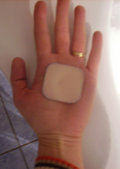Ortho Evra
A contraceptive patch is a transdermal patch applied to the skin that releases synthetic estrogen and progestin hormones to prevent pregnancy. They are thought to have the same effectiveness as the contraceptive pill. Currently the only publicly available contraceptive patch is marketed under the brand name Ortho Evra. Use of this relatively new contraceptive is increasing rapidly, likely because it combines the high effectiveness of contraceptive pills with a more convenient and easy method of administration. Contraceptive patches are often referred to by the slang term "the patch". more...
Method of use
In the United States and Canada, Ortho Evra is available only by prescription and is sold in boxes of three patches. Johnson & Johnson is the largest manufacturer of these patches.
A woman applies her first patch onto her upper outer arm, buttocks, abdomen or thigh on either the first day of her menstrual cycle (day 1) or on the first Sunday following that day, whichever she prefers. The day of application is known from that point as patch change day. Seven days later, when patch change day comes again, the woman removes the patch and applies another in its place. This process is repeated again on the next patch change day. On the following patch change day, the patch is removed and not replaced. The woman waits 7 days without a patch in place, and on the next patch change day she applies a new patch.
Backup contraception
-
- If a woman chooses to begin with her patch change day as day 1 of her menstrual cycle, the patch is able to take effect in time to prevent ovulation (see Mechanism of Action below) and no form of backup contraception is needed at all.
- In the case that a woman wishes to begin using the contraceptive patch following a first trimester abortion or miscarriage, patch application can be done immediately afterwards. This can be considered the same as a day 1 start above, and no backup contraception is required.
- If a woman chooses to begin with her patch change day as the first Sunday following day 1, it is necessary to use a backup form of contraception such as spermicide or condoms for the first week of patch wear.
Mechanism of action
Contraceptive patches are synthetic hormone contraceptives, similar in action to the contraceptive pill. The contraceptive patch product Ortho Evra contains 0.75 mg ethinyl estradiol and 6.0 mg norelgestromin hormones in a single patch. The gradual release of hormones over the course of each week (approximately 20 µg/day ethinyl estradiol and 150 µg/day norelgestromin) act much like contraceptive pills do. Most commonly ovulation is inhibited entirely, preventing pregnancy. Less often the cervical mucus is thickened, making it more difficult for sperm to cross through the cervix and for fertilization to occur.
Interactions and Contraindications
Contraceptive effectiveness of the patch or any other hormonal contraceptive may be reduced significantly if co-administered alongside various antibiotics, antifungals, anticonvulsants, or other drugs that increase metabolism of contraceptive steroids.
However, despite the interactions with many other antibiotics, a clinical pharamacokinetic drug interaction study showed that oral administration of tetracycline HCl 500 mg for 3 days prior to and 7 days during use of Ortho Evra did not reduce effectiveness of Ortho Evra. This is a significant factor in the common decision to administer tetracycline-derived antibiotics following an abortion (preventatively to fight potential infection) when synthetic hormone contraceptives are to be used afterwards.
Read more at Wikipedia.org



